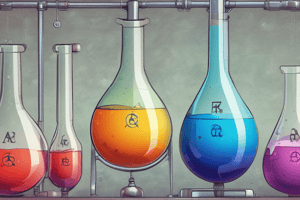Podcast
Questions and Answers
Which statement accurately describes the Brønsted-Lowry theory?
Which statement accurately describes the Brønsted-Lowry theory?
- Acids are substances that turn blue litmus red.
- Bases increase the concentration of hydroxide ions in solution.
- Acids donate protons and bases accept protons. (correct)
- Acids accept protons and bases donate electrons.
Which of the following is a characteristic property of strong acids?
Which of the following is a characteristic property of strong acids?
- They have a pH value greater than 7.
- They do not react with bases.
- They partially dissociate in solution.
- They produce a greater number of hydrogen ions in solution. (correct)
According to Lewis acid-base theory, which statement is true?
According to Lewis acid-base theory, which statement is true?
- Lewis acids accept electron pairs and Lewis bases donate electron pairs. (correct)
- All acids are proton donors.
- Neutralization reactions do not form water.
- Bases only involve hydroxide ions.
In a neutralization reaction, the primary products are usually:
In a neutralization reaction, the primary products are usually:
A weak acid differs from a strong acid in that it:
A weak acid differs from a strong acid in that it:
Which statement best describes the Brønsted-Lowry concept of acid-base reactions?
Which statement best describes the Brønsted-Lowry concept of acid-base reactions?
In the context of the Brønsted-Lowry theory, which of the following characteristics is true about weak acids?
In the context of the Brønsted-Lowry theory, which of the following characteristics is true about weak acids?
What is the primary difference between Brønsted-Lowry acids and Lewis acids?
What is the primary difference between Brønsted-Lowry acids and Lewis acids?
During a neutralization reaction as defined by Brønsted-Lowry theory, which of the following occurs?
During a neutralization reaction as defined by Brønsted-Lowry theory, which of the following occurs?
Which of the following best exemplifies the concept of acid-base equilibrium?
Which of the following best exemplifies the concept of acid-base equilibrium?
Which theory best explains the neutralization reaction between dilute acids and alkalis as the transfer of protons?
Which theory best explains the neutralization reaction between dilute acids and alkalis as the transfer of protons?
Which property differentiates a strong acid from a weak acid during a neutralization reaction?
Which property differentiates a strong acid from a weak acid during a neutralization reaction?
In the context of Lewis Acid-base Theory, what is formed when a Lewis acid reacts with a Lewis base in a neutralization reaction?
In the context of Lewis Acid-base Theory, what is formed when a Lewis acid reacts with a Lewis base in a neutralization reaction?
What is the primary outcome of a neutralization reaction when an acid is mixed with an alkali?
What is the primary outcome of a neutralization reaction when an acid is mixed with an alkali?
What is the role of an alkali in a neutralization reaction involving dilute acids?
What is the role of an alkali in a neutralization reaction involving dilute acids?
Flashcards are hidden until you start studying
Study Notes
Neutralization Reactions
- Dilute acids react with alkalis to produce salt and water.
- This process is referred to as a neutralization reaction.
- Bases and alkalis are capable of neutralizing acids, resulting in the formation of salts alongside water.
Brønsted–Lowry Concept
- Defines acid-base reactions as involving proton transfer.
- Emphasizes that these reactions are universally reversible.
- Conclude with an establishment of acid-base equilibrium as a result of the reaction dynamics.
Studying That Suits You
Use AI to generate personalized quizzes and flashcards to suit your learning preferences.




